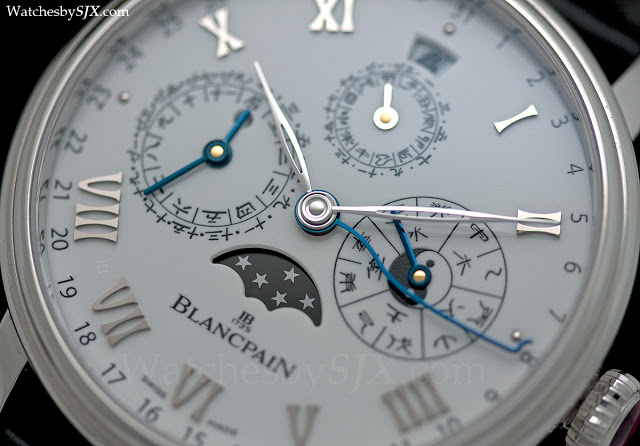Up-Close With The Blancpain Villeret Traditional Chinese Calendar (With Original Photos & Price)

Blancpain take on a wristwatch for the Chinese market is admirably different, equipped with a traditional Chinese calendar mechanism instead of one that displays the common Gregorian calendar.
| Blancpain Chinese Calendar with grand feu enamel dial |
Blancpain for going a step further with the Villeret Traditional Chinese Calendar wristwatch, which it unveiled at Baselworld 2012. And despite the busy dial, I like the watch. Several brands have created Islamic calendar watches, and Svend Andersen made a Jewish calendar timepiece, but the Blancpain is the first Chinese calendar wristwatch. And given the growing Chinese demand for watches, it probably won’t be the last. Pictured is the platinum version, limited to 20 pieces with a ruby set into the crown and another on the rotor. I prefer this to the rose gold version; the platinum is a perfect complement for the white enamel dial and blue hands.
| Blancpain Villeret Traditional Chinese Calendar in platinum |
| The large ruby cabochon |
As I explained in my earlier post introducing the Chinese Calendar watch, the Chinese calendar is lunisolar. According to Blancpain, “The counter at 12 o’clock indicates the double-hour numerals and symbols (24-hour cycle); while the one at 3 o’clock shows the elements and the celestial stems (10-year cycle). The month of the Chinese calendar (12-month cycle), its date (30-day cycle) and the leap month indicator appear at 9 o’clock, while a 12 o’clock aperture reveals the zodiac sign of the year in progress (12-year cycle); and the moon phases are displayed at 6 o’clock.”
The watch is comprehensive in its calendar displays, resulting in sub-dials are that somewhat cluttered. So tiny is the zodiac window at 12 o’clock that it’s nearly illegible.
| Zodiac display showing the dragon |
That is mitigated somewhat by the 45 mm case which means the dial is correspondingly large. Though the case is far from elegant, its size and heft (especially in platinum) is appealing. The watch sits nicely on the wrist, with a reassuring, and expensive, feeling of weight. Blancpain is proud of its enamel dials, and rightly so. The grand feu dial is extremely well made, with a smooth, white surface. It is also beautifully detailed, with precisely painted Chinese characters and applied gold indices.
| I love the blued steel serpentine hand for the date |
A charming detail is the thickness of the enamel dial, which can easily be seen in the semicircular cut-out for the moonphase.
Another notable detail is the mirror polished flange around the dial which reflects the date numerals on the perimeter of the dial. This gives the dial more depth and enhance the impression of quality.
The cal. 3638 inside has a seven day power reserve, as well as other bells and whistles like the free-sprung titanum balance wheel with adjustable gold weights.
| Notice the titanium balance wheel |
As the pictures demonstrate, the movement finishing is also excellent. The calibre has what I call modern haute horlogerie finish, a blend of modern machining and traditional hand finishing.
The bridge for the automatic winding mechanism for instance has a complex shape with lots of curves, and no sharp inward angles, but finished with highly polished bevelling. The watch pictured is a prototype, however, so odd bits here and there are not finished to production standards.
And lest anyone forget what year it is, the pink gold rotor has the obligatory five-clawed dragon in relief.
This could easily have ended up as a kitschy attempt to capitalise on China’s demand for high-end watches, but Blancpain executed it well. The watch looks and feels good, with a level of finishing, inside and out, that is appropriate for the price. The Traditional Chinese Calendar is priced at US$83,600 for the platinum limited edition, and US$66,400 for the rose gold version.